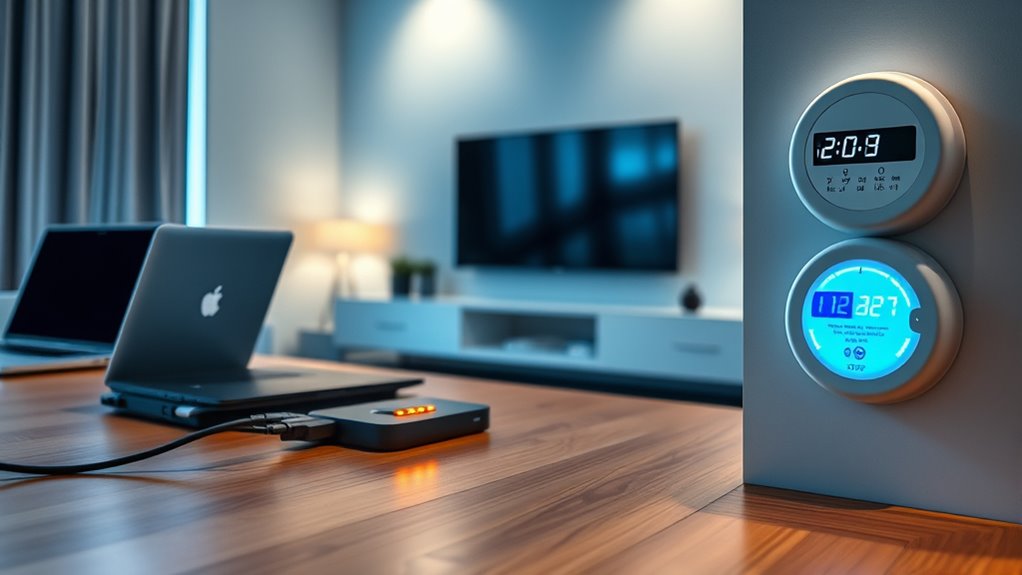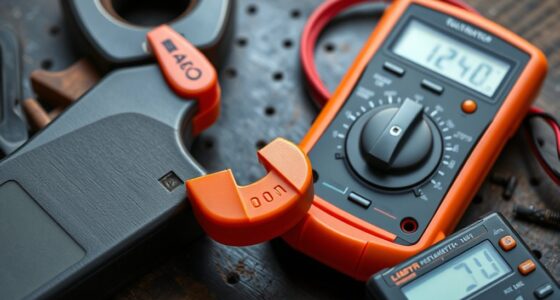To measure phantom loads at home, start by unplugging devices and using a plug-in power meter or a clamp meter to check their standby power consumption. Connect the meter between your outlet and device, then record the wattage draw when the device is off but still plugged in. Regularly monitoring these figures helps identify high standby power devices. Keep exploring to discover more tips on reducing unnecessary energy use and saving on bills.
Key Takeaways
- Use a plug-in power meter or clamp meter to measure the wattage of devices in standby mode.
- Unplug devices, connect the meter between the outlet and appliance, then record the wattage when devices are off.
- For multiple devices, measure each separately to identify high standby power consumers.
- Compare readings to typical standby power levels (1-5W for electronics, higher for larger appliances).
- Regularly monitor and evaluate device power usage to identify and reduce unnecessary phantom loads at home.
Understanding Phantom Loads and Their Impact

Many electronic devices draw power even when they’re turned off, a phenomenon known as phantom loads. These hidden energy drains can considerably increase your electricity bill over time. To minimize this impact, start with simple energy saving tips, like unplugging devices when not in use or using power strips to switch off multiple gadgets at once. Regular appliance maintenance also helps ensure devices operate efficiently, reducing unnecessary power consumption. For example, keeping chargers, TVs, and computers unplugged when idle prevents phantom loads from wasting energy. Understanding which devices contribute most allows you to target specific appliances for better energy conservation. Being aware of Best Modern Toilet features, such as efficient flushing mechanisms, can also help reduce overall energy use. Additionally, choosing energy-efficient appliances with Energy Star ratings can significantly lower your home’s energy footprint. Incorporating smart home technology can further optimize energy use by automatically managing phantom loads and adjusting power settings based on actual needs. Research shows that some AI-driven solutions are now being deployed to detect and manage phantom loads more effectively. Implementing energy monitoring systems provides real-time insights into energy consumption, empowering you to make smarter decisions. Managing phantom loads not only saves money but also reduces your home’s overall energy footprint, helping you become more environmentally conscious.
Gathering the Right Tools for Measuring Standby Power

To measure standby power accurately, you need the right tools, starting with essential devices like plug-in power meters or multimeters. Make certain these tools are compatible with your appliances and can handle the low power levels involved. Also, check their calibration and accuracy to ensure your readings are reliable and meaningful. For added confidence, consider using tools that have been tested for precision in low-power measurements, especially when assessing phantom loads. Additionally, understanding electrical safety protocols is crucial when working with these devices to prevent accidents and ensure accurate measurements. Incorporating appropriate measurement techniques can further improve the reliability of your assessments.
Essential Measuring Devices
Choosing the right measuring devices is essential for accurately evaluating standby power consumption. For effective energy auditing and improved power management, you’ll need a reliable power meter or clamp meter designed to measure low wattages. These devices can detect phantom loads without interfering with device operation. A plug-in power meter is ideal for checking individual appliances, giving you real-time readings of energy use. If you want to measure multiple circuits or larger loads, a clamp meter can help by measuring current without unplugging devices. Make sure your tools have sufficient sensitivity to detect small power draws typical of standby modes. Using precise measuring devices ensures you gather accurate data, empowering you to identify and reduce unnecessary energy consumption effectively. Additionally, understanding phantom loads can help prioritize which devices to measure first for maximum energy savings. Being aware of electric power generation with bike generators can also inspire creative ways to monitor and manage energy use in off-grid or sustainable setups. Proper measurement techniques can also reveal the impact of artificial lighting and other subtle energy drains in your home. Moreover, selecting tools with appropriate measurement accuracy ensures your readings are reliable, leading to better decisions on energy reduction strategies.
Compatibility Considerations
Selecting compatible measuring tools is essential to ensuring accurate standby power assessments. You need devices that match the power range and provide precise readings for your appliances. Compatibility considerations include checking if the meter supports low wattage measurements, especially for energy-saving tips that target phantom loads. Additionally, verify if the tool can handle different plug types and voltage levels common in your home. Appliance labeling often indicates power consumption, but a compatible meter confirms actual standby draw. Using the right tools ensures your measurements are reliable, helping you identify which devices waste energy and implement effective energy-saving tips. Proper compatibility prevents inaccurate data, making your efforts to reduce standby power more effective and informed. As technology advances, selecting tools that incorporate AI-driven security systems can also help monitor and protect your energy management devices. Incorporating smart home integration features in measuring tools can further enhance real-time energy monitoring and control. Furthermore, choosing meters with high accuracy and reliability ensures your data reflects true energy consumption, aiding in better energy management decisions. Understanding phantom loads is crucial because they can account for a significant portion of household energy waste, and selecting the right tools helps in accurately identifying these hidden power drains. Additionally, selecting tools with user-friendly interfaces makes it easier to perform regular assessments and interpret the data effectively.
Calibration and Accuracy
Ensuring your measuring tools provide accurate readings starts with proper calibration. You should regularly use calibration techniques to verify your device’s measurement accuracy, guaranteeing it reflects true power consumption. Many digital power meters have built-in calibration options or require external calibration sources. Follow manufacturer instructions carefully to calibrate your device correctly. Accurate calibration minimizes measurement errors, giving you reliable data on phantom loads. Keep in mind that even small inaccuracies can lead to misjudging energy use, so it’s worth investing time in calibration routines. Periodic checks ensure your measurements stay precise over time, especially when tracking standby power consumption. Proper calibration procedures are essential for achieving measurement accuracy and ensuring your data is trustworthy. By prioritizing calibration and instrument precision, you can confidently identify which devices draw power when turned off and take effective steps to reduce unnecessary energy use. Additionally, understanding measurement reliability helps in selecting the right tools for detailed energy analysis. Regularly verifying your tools with standard calibration sources ensures consistent performance over the long term.
Identifying Devices That Consume Standby Power

Many household devices use standby power even when you’re not actively using them. Look for visual indicator lights or buttons that stay lit, signaling ongoing power use. Remote-controlled electronics, like TVs and chargers, are common culprits that often draw power in standby mode. Additionally, some appliances may have energy-efficient features that still consume small amounts of power when turned off but plugged in. To effectively reduce phantom loads, it’s helpful to understand home energy management strategies that can cut down on unnecessary power consumption. Recognizing electrical load patterns can help identify which devices contribute most to standby power use and optimize energy savings. Implementing smart power strips can further minimize idle power draw by automatically cutting power when devices are not in use.
Common Household Devices
Have you ever noticed how some household devices seem to stay on even when you’re not using them? These devices often draw standby power, especially in a smart home setup where features like remote control or voice activation are common. Recognizing these devices helps reduce energy waste and supports renewable energy efforts. Common culprits include:
- TVs with remote controls that stay on for quick access
- Chargers left plugged in, even when not charging
- Home assistants and smart hubs that remain active for connectivity
Visual Indicator Lights
Visual indicator lights on devices are a clear sign that they’re consuming standby power. These visual cues, such as LED indicators, show the device is ready to operate even when turned off. Recognizing these lights helps you identify phantom loads easily. For example, a TV with a small red LED or a router with blinking lights draws power constantly. To better understand, look at the table below:
| Device Type | Indicator Light | Power Consumption |
|---|---|---|
| Television | Red LED | Moderate |
| Wi-Fi Router | Blinking LED | Low |
| Audio System | Standby Light | Slight |
Remote-Controlled Electronics
Remote-controlled electronics often draw standby power even when you’re not actively using them. These devices maintain remote control functionality and often stay in power saving modes to respond quickly when needed. This constant energy draw can add up over time, increasing your energy bill. To identify these devices, check for features like quick start or instant-on modes.
- Devices that respond immediately to remote commands
- Equipment with power saving modes that still consume some standby power
- Electronics with indicator lights that stay on even when off
Step-by-Step Guide to Measuring Phantom Loads

Wondering how to accurately measure the phantom load of your devices? First, unplug the appliance, then connect a power meter between the outlet and your device. Turn on the device and record the wattage reading. To guarantee accurate measurement, repeat this process for different devices. Use the table below to compare typical power usage:
| Device Type | Typical Power Draw | Energy Conservation Tip |
|---|---|---|
| Small Electronics | 1-5 watts | Unplug when not in use |
| Large Appliances | 10-50 watts | Use smart power strips |
| Chargers (phone, etc.) | 1-3 watts | Switch off or unplug |
| Standby Devices | 2-10 watts | Enable power-saving modes |
This process helps you identify which devices drain power unnecessarily, improving appliance efficiency and reducing energy waste.
Interpreting Your Measurement Results

Once you’ve recorded the wattage readings from your devices, it’s important to compare these numbers against typical power usage to understand their efficiency. Lower readings generally indicate better energy efficiency and less waste. If your devices consume more power than expected, it may signal poor power management or phantom loads. To interpret your results effectively, consider these points:
- Identify devices with unusually high standby power that could benefit from optimization.
- Recognize patterns where certain appliances consistently draw more power, indicating inefficiency.
- Use your measurements to prioritize which devices to upgrade or unplug for better power management.
Tips for Reducing Standby Power Consumption

Reducing standby power consumption starts with simple, proactive steps to cut unnecessary energy use. Switch to energy-efficient appliances that consume less power even in standby mode, making a noticeable difference over time. Practice power saving habits like unplugging devices when they’re not in use or using power strips to turn off multiple electronics at once. Enable power-saving settings on your devices to minimize energy drain. Regularly monitor and assess your electronics’ standby consumption to identify high-energy culprits. Educate yourself about energy-efficient alternatives and incorporate them into your home. These small changes can appreciably reduce phantom loads, lowering your energy bills and environmental impact. Consistent effort with smart habits can make your home more efficient and eco-friendly.
Frequently Asked Questions
How Often Should I Check for Phantom Loads in My Home?
You should check for phantom loads at least once every three to six months. Regularly testing your appliances helps you identify unnecessary energy drain, saving you money and reducing waste. Incorporate energy-saving tips like unplugging devices when not in use and maintaining appliances properly. Frequent checks make certain you’re actively managing standby power, keeping your energy consumption efficient and your bills lower. Stay proactive with appliance maintenance to optimize energy use.
Are There Specific Brands of Meters Better for Measuring Standby Power?
Some meters are better for measuring standby power because they offer higher meter accuracy and better device compatibility. Look for models like Kill-A-W watt or P3 International that are known for precision and can handle various devices. These brands help you get reliable readings, so you can identify phantom loads effectively and save energy. Always check reviews to make sure the meter suits your specific needs.
Can Phantom Loads Damage My Appliances or Increase Fire Risk?
While phantom loads are usually gentle whispers of energy, they rarely pose a real threat to your appliance safety or increase fire hazard. However, persistent standby power can cause minor wear over time, subtly stressing your devices. By unplugging unused electronics or using smart power strips, you minimize risks, guarantee your appliances stay safe, and keep your home cozy without the faintest worry about hidden dangers lurking behind the scenes.
Is It Cost-Effective to Unplug Devices That Have Standby Power?
Unplugging devices with standby power is definitely cost-effective, as it boosts your energy efficiency and leads to tangible cost savings on your electricity bill. By cutting off phantom loads, you prevent unnecessary energy consumption, which adds up over time. While it might seem small, consistently unplugging unused devices helps reduce your overall energy waste, saving you money and supporting a greener, more energy-efficient home environment.
How Do Smart Home Devices Impact Overall Standby Power Consumption?
Smart home devices often reduce standby power by turning off appliances automatically, saving energy. For example, a family uses energy-efficient appliances connected to smart power strips, which cut power when devices aren’t in use. This setup minimizes phantom loads, making their home more energy-efficient. By integrating smart devices, you can effectively manage standby power, lower energy bills, and contribute to a greener environment effortlessly.
Conclusion
By keeping an eye on those quiet energy users, you can gently encourage your home to use power more wisely. A little awareness goes a long way in making your space both cozy and efficient. With your newfound knowledge, you can subtly trim unnecessary consumption, all while maintaining comfort. Remember, small changes add up, turning your home into a more mindful place—where energy savings become a natural part of your daily rhythm.









